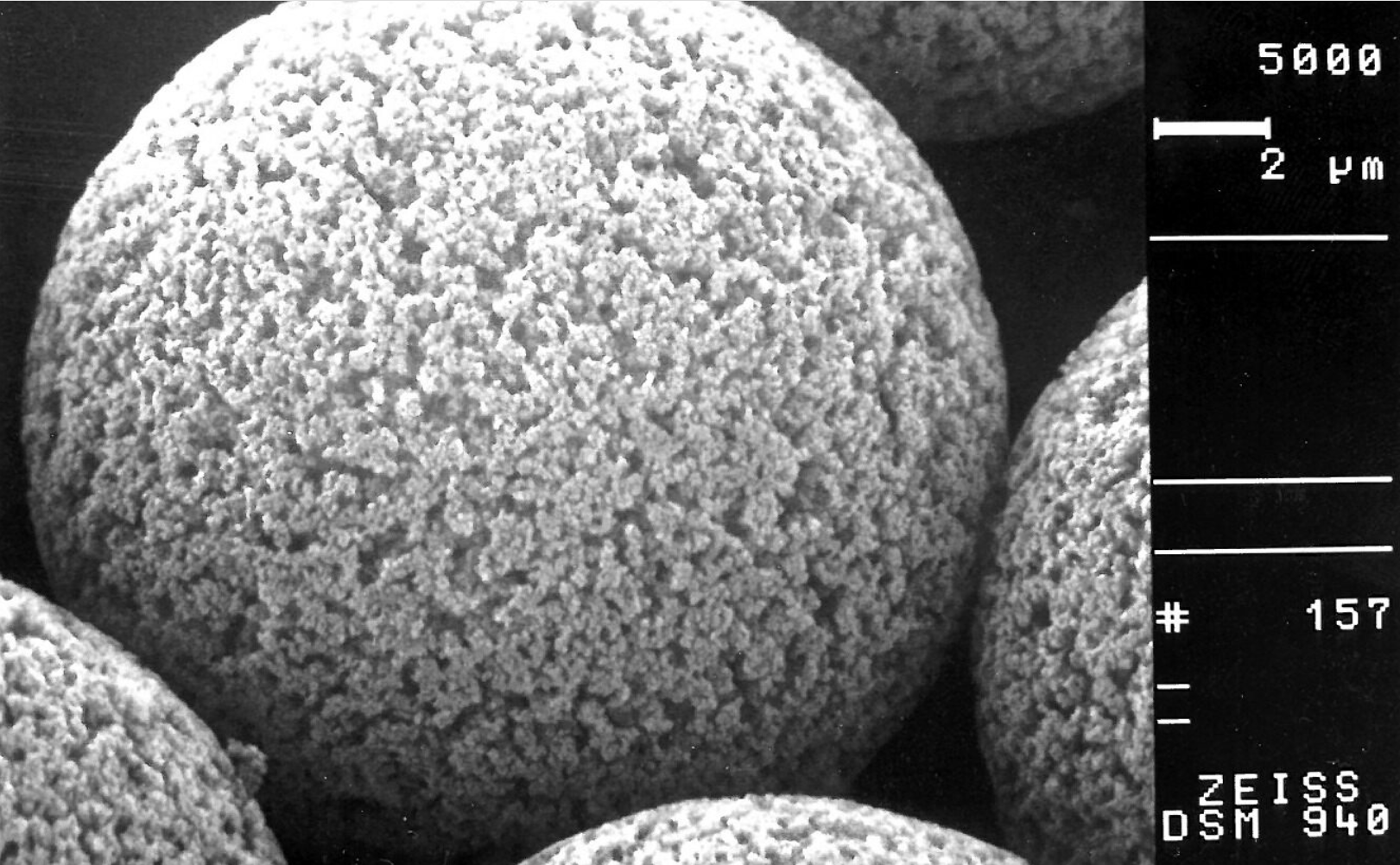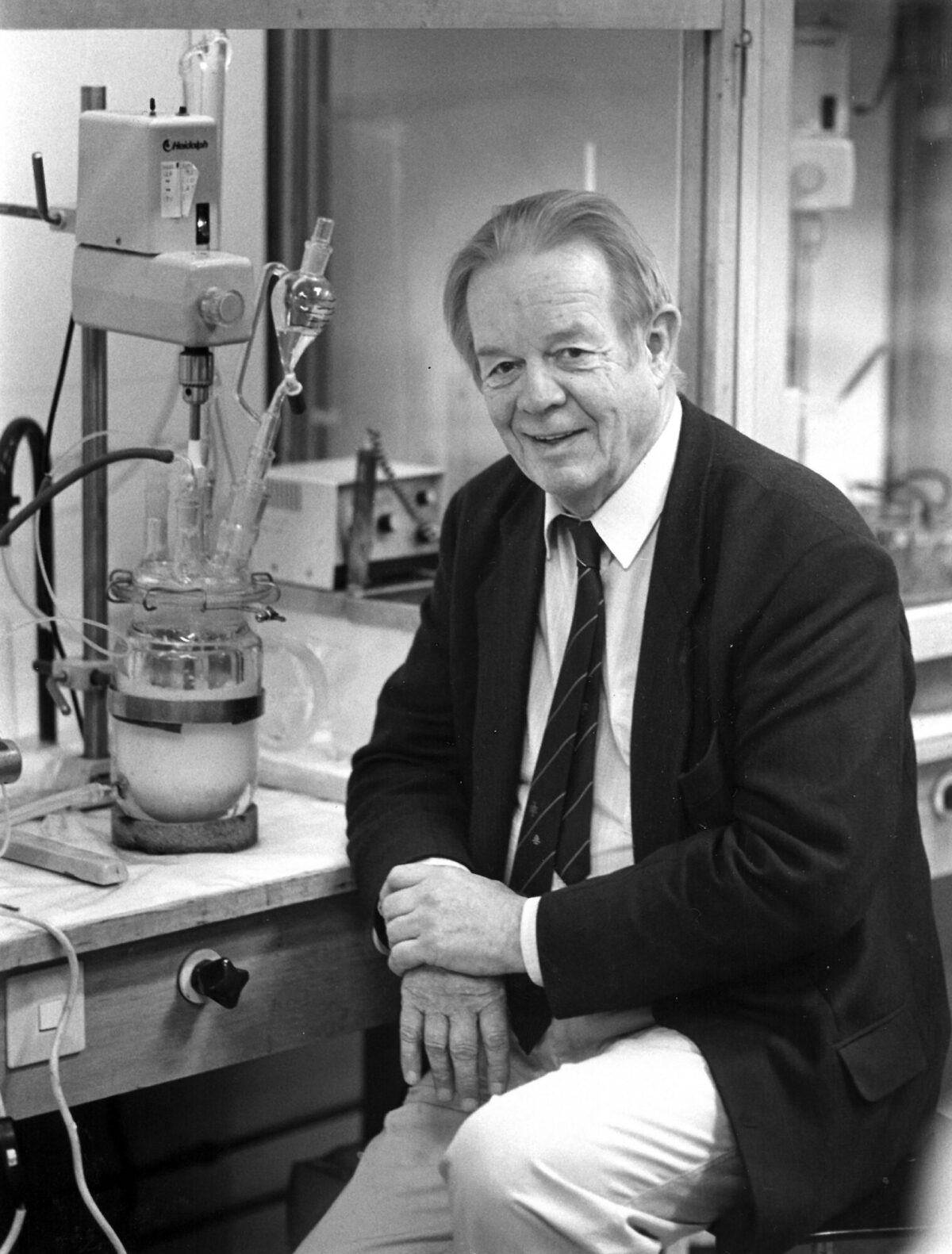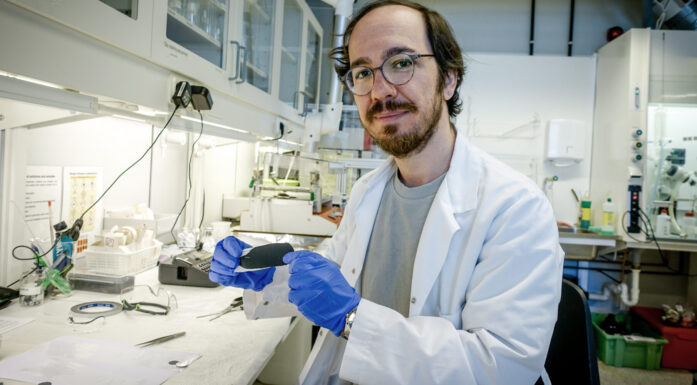The big little discovery
A project that American researchers had given up on. An absent-minded professor who had disliked school as a child. A good portion of curiosity. That is how the story of the Norwegian Ugelstad spheres began. Today they save millions of lives.
Jan Kai Nymoen was 30 years old and worked as a cabinetmaker.
“One day I came home from work and wanted to take a shower. That’s when I discovered a lump in my groin.”
That was the start of a twenty-year long disease process with repeated chemotherapy courses and other types of treatment. Working became impossible for Nymoen, and his social life evaporated.
“The doctors didn’t say much about my future prognosis. That type of cancer, follicular lymphoma, can turn into an aggressive type,” says Nymoen.
Nymoen tried various treatments and constantly had to go in for check-ups. In 2023, the cancer turned into an aggressive form.
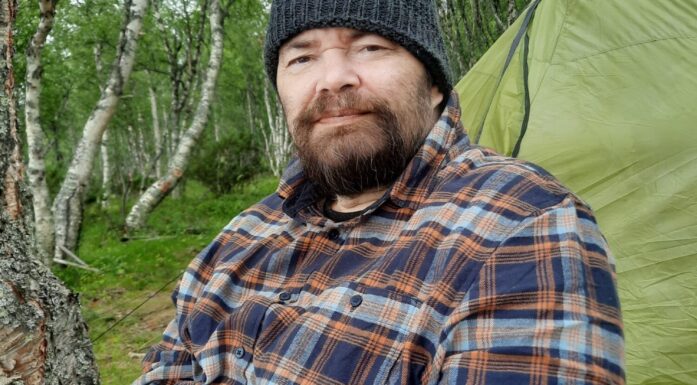
Jan Kai Nymoen from Surnadal was 30 years old when he was diagnosed with lymphoma. In 2023, he developed the aggressive form. Shortly after, Radiumhospitalet began offering the new CAR-T treatment. “If I hadn’t received CAR-T, things would have gone badly,” says Nymoen, who is now healthy. Photo: Private
“I was lucky,” says Nymoen.
Just a short time later, the Norwegian Radium Hospital in Oslo started using CAR-T cell therapy.
Paradigm shift
Surgery, chemotherapy, antibody and radiation therapies. For many years, these have been the methods available to cure cancer, but recently, a new type of treatment has come onto the scene: a treatment in which Ugelstad spheres, also called beads, play a central role.
“A lot of patients who initially had poor life expectancy are now completely cured. It’s fascinating and fantastic to be a part of this form of treatment,” says Unn-Merete Fagerli. She is a senior consultant for the Cancer Clinic at St. Olavs Hospital in Trondheim. In the fall of 2024, St. Olavs became the first hospital outside Oslo to use the new CAR-T cell therapy for seriously ill lymphoma patients.
Using the immune system to kill cancer cells has been a paradigm shift in cancer treatment. CAR-T (chimeric antigen receptor T-cell) cell therapy is the newest and most advanced form of immunotherapy, in which the patient’s own T-cells are trained to be able to kill cancer cells.
Training camp for immune cells
“The special thing about CAR-T is that we can extract the patient’s own T-cells and use them to treat the cancer. But first the cells have to be trained, get stronger and be equipped with tools to find the cancer cells,” says Fagerli.
In practice, this is done by taking T-cells from the patient and sending them to a laboratory in the Netherlands. There, they are genetically modified and multiplied, before being returned to the hospital to be reintroduced into the patient.
At the heart of this process is a Norwegian invention. Tiny magnetic beads are used to pick out certain parts of the blood sample, inject the cells with the new gene and ensure that they multiply.
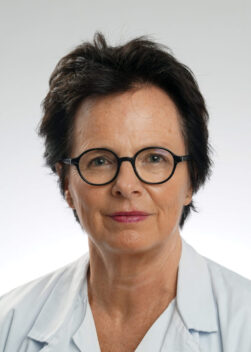
Despite numerous acute side effects, many patients experience the CAR-T treatment as much less stressful than other therapies they have received, says Unn-Merete Fagerli, a senior consultant for the Cancer Clinic at St. Olavs Hospital. Photo: Geir Otto Johansen/St.Olavs Hospital
These beads are not only used for advanced cancer treatment. They are also applied in billions of diagnostic tests that save millions of lives each year.
The Ugelstad beads are among the greatest medical inventions of the last century, created in a lab at SINTEF in Trondheim on a cold December day in 1977.
Bad marks
Young John Ugelstad’s parents back home in Trondheim would likely have been surprised to learn that he would eventually be declared a genius professor, a pioneer in polymer and colloid chemistry and have a building named after him in the new Oslo Cancer Cluster innovation park.
As a child, Ugelstad had little interest in school. He preferred to spend his time playing football.
Graduating from the Trondheim Cathedral School at the age of twenty, his marks were so poor that he had to go to work before he could be admitted to the Norwegian Technical University (then NTH – now part of NTNU).
Nevertheless, he graduated from NTH with top marks in 1948. He created his first invention: making jacket buttons from fish waste. The military bought a large batch, but it was not a success. After the first laundering of the uniforms, all the buttons were gone, and the washing machine was full of a foul form of fish soup.
“I felt like a complete failure,” Ugelstad was heard to say after the incident. Then he travelled to the Netherlands and studied for a doctorate in polymer chemistry.
That was in the 1950s, the golden age of plastics. Materials like polyethylene, polypropylene, PVC, polystyrene and Teflon were being mass-produced and becoming part of people’s daily lives. This is what polymer chemistry is all about. You start with a small molecule, a monomer, and let it grow into a large molecule – a polymer.
This is how synthetic materials like plexiglass and nylon are manufactured.
Ugelstad returned to NTH and SINTEF in Trondheim after his doctoral studies. He has been described as a workaholic who could completely lose track of time, who always came home late and more than likely had forgotten his dog in the office. His desk was typically strewn with papers, and he was always absorbed by a problem that had to be solved.
“Why go into space when you can go to Trondheim?”
That was the headline of a short article in Newsweek from the late 1970s.
Ugelstad had been to a conference in the USA, where scientists were struggling to produce microscopic plastic spheres. The beads all had to be perfectly uniform so they could be used to calibrate instruments that required high accuracy.
The idea – call it inspiration, if you like – came to me one night in 1977. I think best at night. I turned the problem of the beads over and over in my mind. Then the idea hit me!
But the scientists hadn’t succeeded in making the beads larger than a few hundred nanometres, which for many applications was not nearly big enough.
The Americans had given up, and thought it could only be done in a weightless state. That is, in space.
How Ugelstad spheres are used
Magnetic beads:
- immunotherapy and cell-based treatment
- diagnostics of many diseases and viruses/bacteria
- DNA and RNA isolation
- protein purification and analysis
- stem cell and cell technology
- food safety and microbiological testing
Non-magnetic beads:
- calibration and standardization in measuring instruments
- industrial use in plastics, cosmetics and paints
- electrically conductive adhesives and coatings
- spacers in advanced electronics
- chromatography
“The idea – call it inspiration, if you like – came to me one night in 1977. I think best at night. I turned the problem of the beads over and over in my mind. Then the idea hit me! I got up and sat down at my desk, calculated and analysed. Yes, I was right. It had to be possible to produce the beads on Earth,” Ugelstad said later.
The next day he tested his calculations from the night’s work in the laboratory, and they were absolutely correct. Under the magnifying glass, plastic spheres – all exactly the same size – were growing, with a diameter of a few thousandths of a millimetre. The discovery was a world sensation.
Ingenious magnetism
“I’m out in the world at a conference, and I say I’m from SINTEF. ‘Well, what’s that?’ I’m asked. Then I say ‘Dynabeads,’ and people light up. It’s always been like that. The Ugelstad spheres, yes – they’ve heard of those.”
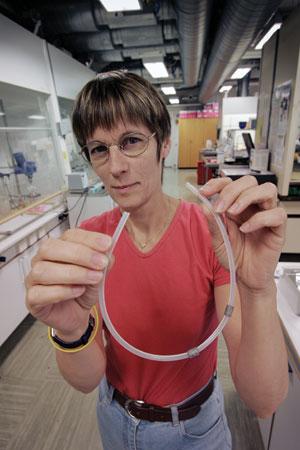
Ruth Schmid had a long research career at SINTEF. She shows off a new material, based on the Ugelstad balls, in 2013. Photo: Thor Nielsen
Ruth Schmid used to be a marketing manager at SINTEF and is now retired. She was a key figure in developing SINTEF’s nanomedicine environment. When Schmid began her career in the early 1980s, she worked closely with Ugelstad and his two collaborators, Turid Ellingsen and Arvid Berge.
These four individuals were the ones who really made the big breakthrough with the spheres. By making them porous, they could fill them with iron salts, enabling the beads to be made paramagnetic. This means that they are magnetic only when in a magnetic field. As soon as the magnetic field is turned off, they cease to be magnetic. This prevents the spheres from clumping together, so they flow evenly into the solution again.
Schmid describes Ugelstad as a scientific genius who was not always easy to work with.
“He could be really excitable. I had a lot of discussions with him, where I had to get out for a walk in the woods afterwards. But he always apologized.”
Expert in thermodynamics
According to the SINTEF researchers, there isn’t that much hocus-pocus to creating monodisperse (identical size and shape) particles – if you just know how to do it.
“Ugelstad actually mentioned several times that he didn’t understand why no one else had come up with the discovery before him,” says Heidi Johnsen, a research manager at SINTEF.
The challenge was to create particles of exactly the same size, larger than particles that can be made with emulsion polymerization, which typically only grow up to 500 nanometres.
“The starting point for the Ugelstad process is to have many exactly uniform ‘seed particles,’ small seeds that are created by emulsion polymerization,” says Johnsen.
At first, creating standards for calibrating instruments was the top priority. In addition, people started to buy large TV screens, where such particles were needed to make the image on the LCD screen sharp.
In emulsion polymerization, the monomers – the tiny molecules that make up the polymer (plastic) – are distributed in water.
“When this kind of particle is in a water mixture that also contains monomers, the monomers will move into the seed particle, causing it to begin to swell. How much it can swell is governed by the laws of thermodynamics.”
“Polymerization can be initiated when the particle has completely swollen, turning the monomers into a polymer.
The process up to this point was already understood before Ugelstad made his great nocturnal discovery. The problem before the discovery was that the spheres could not be swollen to more than two to five times their own volume.
However, thermodynamics in such emulsion processes was Ugelstad’s field of expertise.
“He realized that using certain specific excipients would provide a helping hand so that the particle could swell much more, to over 1000 times its own volume,” says Johnsen.
In addition, the excipients helped stabilize the swollen particles, which would otherwise clump together, says Schmid. In this way, you could start with exactly the same sized seeds and end up with exactly the same sized swollen particles.
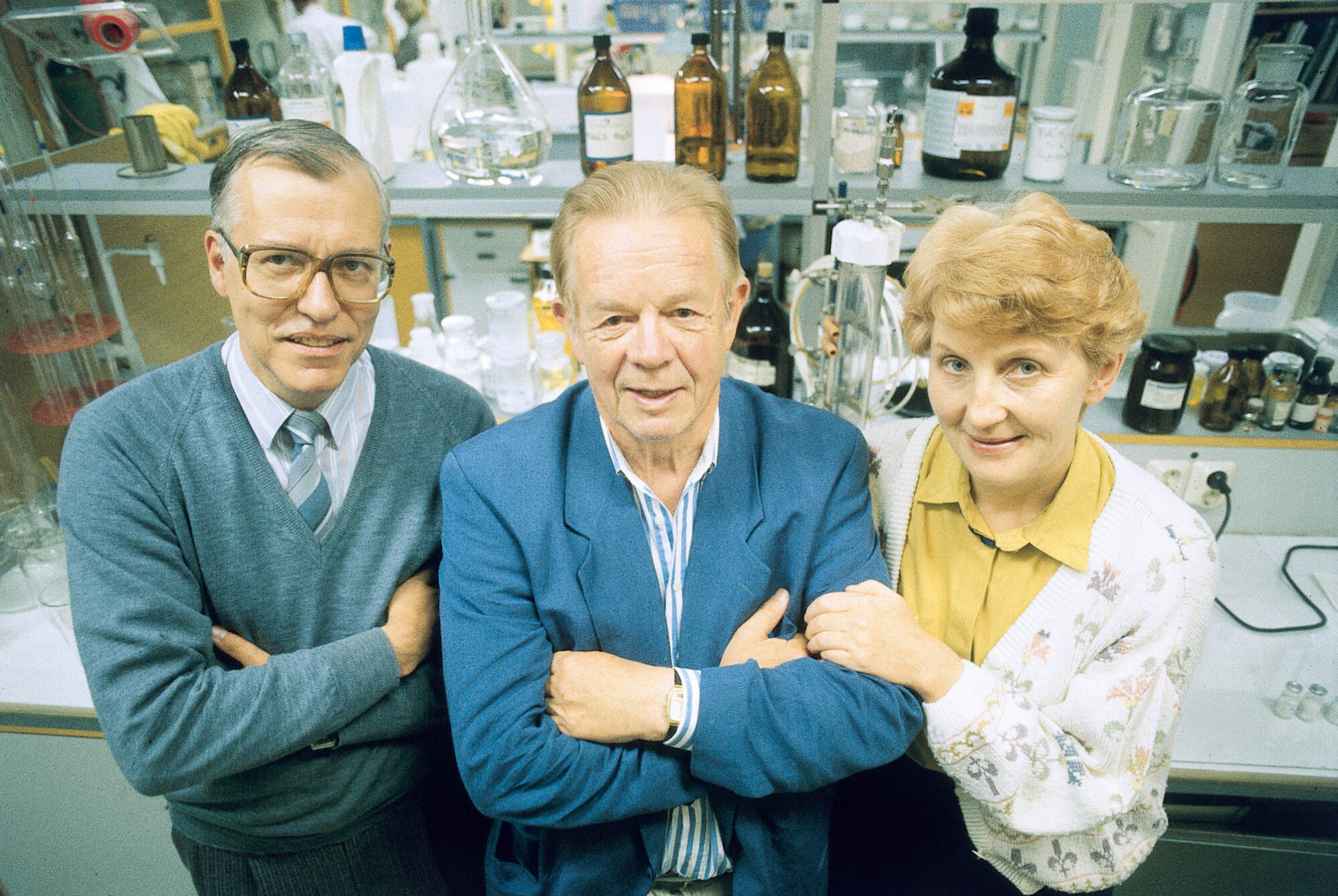
John Ugelstad, born in Trondheim in 1921, began working at SINTEF’s Department of Industrial Chemistry in 1957. Nine years later he became a professor at the Norwegian Institute of Technology (NTH), where he remained for the rest of his career. Ugelstad died on 3 April 1997. Here he is flanked by his closest collaborators, Arvid Berge and Turid Ellingsen. Photo: Jens Søraa
When Ugelstad made the discovery, he supposedly said the idea was so simple that a child could do it. He then hurried to apply for a patent on the method.
“At first, creating standards for calibrating instruments was the top priority. In addition, people started to buy large TV screens, where such particles were needed to make the image on the LCD screen sharp,” Schmid says.
In other words, when SINTEF started making Ugelstad spheres in the early 1980s, they had no idea how significant the discovery would become for medicine. Dyno Industrier, which dealt in explosives and paints, bought the rights to the particle production – without quite knowing what they would use it for.
Treating many forms of cancer
Today, the spheres play a key role in modern biotechnology and medicine.
“We’ve used the Ugelstad spheres extensively in our research. It is an invention that has had an impact in immunology and cell therapy all over the world,” says Professor Johanna Olweus, who heads the research on experimental immunotherapy at Oslo University Hospital. Olweus calls the beads a simple but ingenious invention.
“The fact that they’re magnetic means that you can use them to extract precisely the cells you want, even if they make up as little as one percent of the total cell content.
In CAR-T cell therapy, where the patient’s own T-cells are genetically modified, the beads are used in several steps of the process.
The spheres have a very large surface area, which means you can coat them with different molecules that can provide specific stimuli to the T-cells.
“A cornerstone of immunotherapy research, and of clinical treatment, is that you use the beads both to stimulate the T-cells and to activate them so that they can be genetically modified. The beads have a very large surface area. This means that you can coat them with different molecules that can provide specific stimuli to the T-cells.”
Olweus is researching how to use immunotherapy to treat several types of cancer, not just those that CAR-T is used for today.
“The reason CAR-T therapy works is that the T-cells are adding a gene that codes for a receptor on the outside of the T-cells. When the T cell recognizes a molecule on the cancer cell via this receptor, the T cell is activated and attacks the cancer cell.”
This works fine for cancers like lymphoma, where the cancer cells have completely unique molecules on their surface. However, many types of cancer lack these unique surface molecules. Instead, they hide them inside the cancer cells.
“Since the T-cells only recognize molecules on the surface of the cancer cell, we are very limited on which molecules the T-cells can target. Ninety percent of the proteins are inside the cells.”
The solution could lie in a new treatment method, called T-cell receptor therapy (TCR). Here, a receptor that can recognize certain proteins found inside the cancer cells is added to the T-cells.
“This dramatically increases the number of possible new treatment targets,” says Olweus.
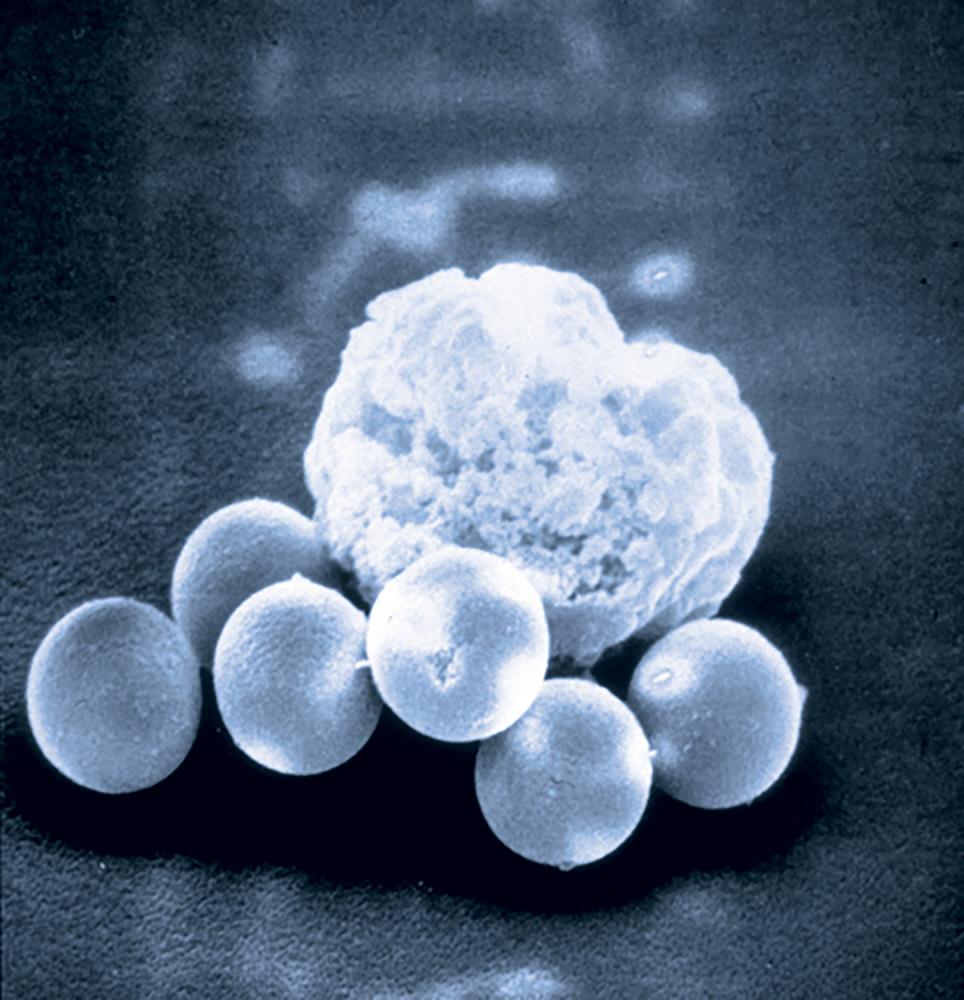
Here, Ugelstad spheres have attached themselves to a cancer cell that can now be extracted from the patient’s body, because the spheres are magnetic. Ugelstad spheres also play a crucial role in modern electronics and are used in both cosmetics and industrial products. Photo: Unknown
An industrial adventure
Oslo, March 2025. The Oslo Cancer Cluster Innovation Park is being built right next door to the newly expanded Radium Hospital. Thermo Fisher Scientific, the American biotechnology company that now owns the Ugelstad beads, will move into the 12 000 square metre John Ugelstad building with a new research department.
The Ugelstad beads have become crucial in genetic testing and are inextricably linked to the “next-generation sequencing” (NGS) concept, a technology that can map genomes and study which genes are linked to certain diseases.
Immunotherapy has in turn become part of the standard treatment for a number of cancers.
Staying in Norway
The current investment also includes an expansion and upgrade of the production facility in Lillestrøm. The Ugelstad beads, or Dynabeads as they now are called, have been produced there since the start in the 1980s.
The facts
After Dyno industrialized the Ugelstad beads in the 1980s and established Dynal Biotech with Apothekernes Laboratorium, Dynal underwent several changes of ownership. Today, the company is owned by Life Technologies, which is in turn owned by the American biotechnology giant Thermo Fisher Scientific. Since 2010, Thermo Fisher Scientific has almost tripled its investments in research and development in Norway, in fields such as cell therapy, mRNA vaccine technology, diagnostics and basic research.
“Chemically, the processes are the same as the ones developed by Ugelstad, but the production is now more advanced and on a much larger scale. Producing the beads takes around 16 weeks, starting from scratch with basic chemicals, and without the use of semi-finished products from outside,” says Anne Haugland, Director of Operations and Site Leader for production at Lillestrøm.
The Ugelstad beads have also led to the establishment of other Norwegian industries. Conpart and Microbeads produce products for electronics and large-scale industrial applications, such as paints and varnishes, and cosmetics, respectively.
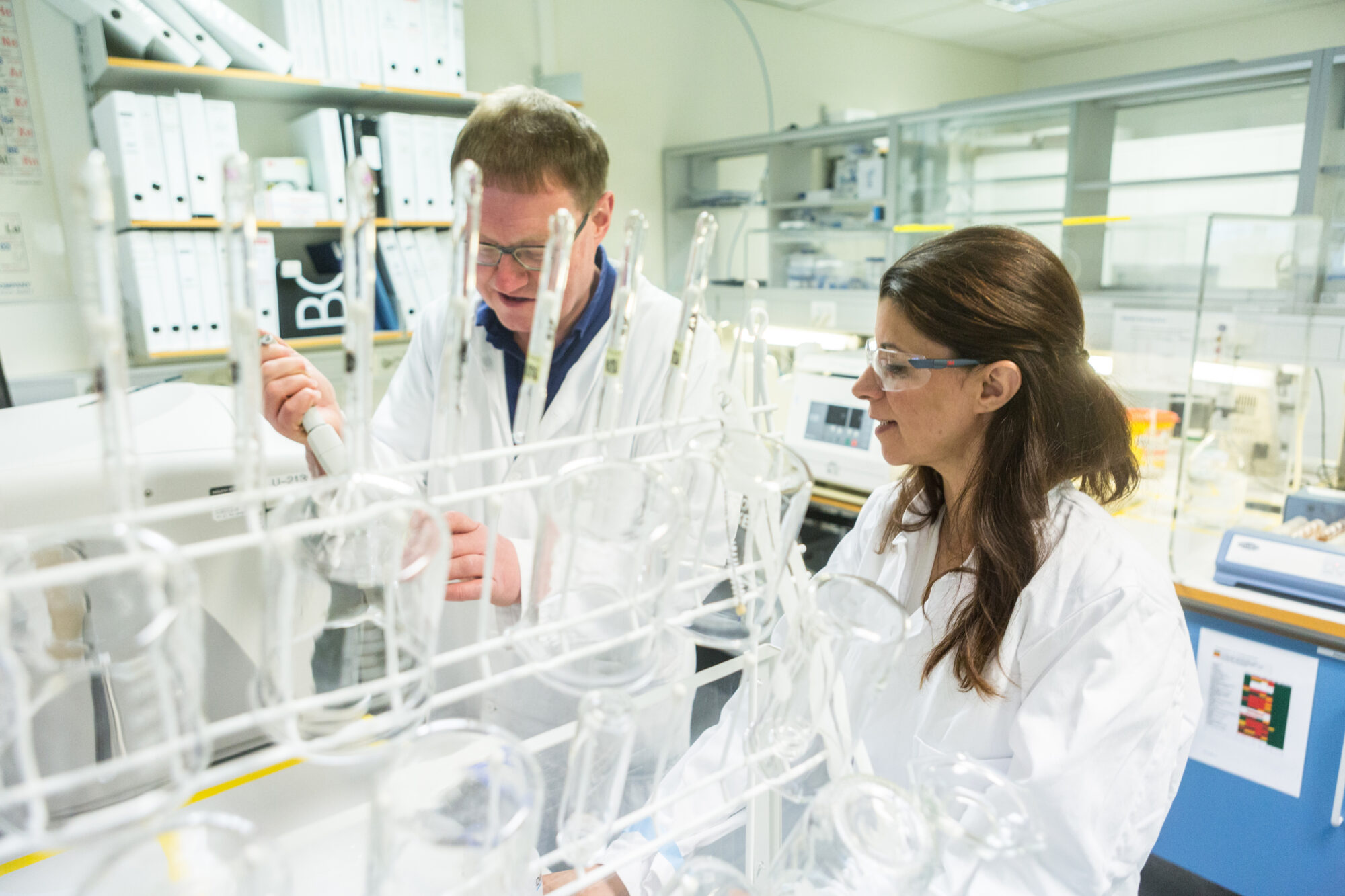
Engineers Svein Morken and Roksana at work in the Analysis Laboratory at Thermo Fisher Scientific, which produces the Ugelstad balls in the Lillestrøm factory. Photo: Johnny Syversen
Major spin-offs
The collaboration with Dynal and what has now become part of Thermo Fisher Scientific has meant a lot to SINTEF on various levels,” says research manager Johnsen.
“We feel that we’ve contributed to developing something that has helped so many people – and created a lot of jobs and activity here in Norway.”
The development of the Ugelstad beads also provided valuable experience in industrial establishment and the path from basic research to commercial production. Johnsen highlights the RESMAN company as an example.
RESMAN, which operates in oil and gas extraction, was sold for a billion Norwegian kroner 15 years after its start of operations.
“The same environment that worked with the spheres contributed greatly to establishing this company. From the outside, it appears to be a completely different field. But it was the knowledge that we brought with us that was used in a completely different direction,” says Johnsen.
Schmid emphasizes that the experiences from the Ugelstad era were important for today’s nanoparticle research in Trondheim.
“Processes for making paint and varnish were the starting point. We’ve continued to use those principles, but now we’re applying them to making nanoparticles for medical applications,” says Schmid.
Laid the foundation for nanomedicines
Nadeno started as a spin-off company from SINTEF in 2022 that is developing a new cure for metastases in the abdominal cavity. They will use nanoparticles to transport cancer medicine into the tumours. The legacy from Ugelstad is notable here as well.
“The nanoparticles themselves have nothing to do with the Ugelstad spheres, but they are based on the same thermodynamic principles. The particles are fully loaded with cancer medicine, and at the same time they have a surface that allows them to adhere to the mucosa where the metastases are,” explains Schmid.
This is how the particles accumulate around the cancerous tumours, while at the same time breaking down over time. In this way, they slowly but surely deliver the medicine they carry into the cancerous tumours.
“In mice, we’re seeing one hundred percent of the tumours disappear. And they don’t grow back.”
Nadeno could start clinical tests as early as next year. At the same time, other SINTEF researchers are working on using nanoparticles in a similar way to treat lung cancer.
The researchers at SINTEF envision that this way of delivering drugs could also be used to treat other lung diseases, such as cystic fibrosis, infections and emphysema.
A life with cancer
It’s Christmastime 2023, and Jan Kai Nymoen is a patient at the Norwegian Radium Hospital. He has been injected with his own T-cells, now genetically modified and specially trained to fight the aggressive cancer in his lymphatic system. He will be in bed for a week with a high fever while the treatment takes effect in his body.
“I was really excited. I knew the treatment didn’t work for everyone. But I had no choice. If I hadn’t taken CAR-T, things would have gone badly,” says Nymoen.
After eight weeks at Radium Hospital, he was allowed to go home. He had a follow-up check-up at St. Olavs hospital in Trondheim.
“By then the cancer was gone,” says Nymoen.
